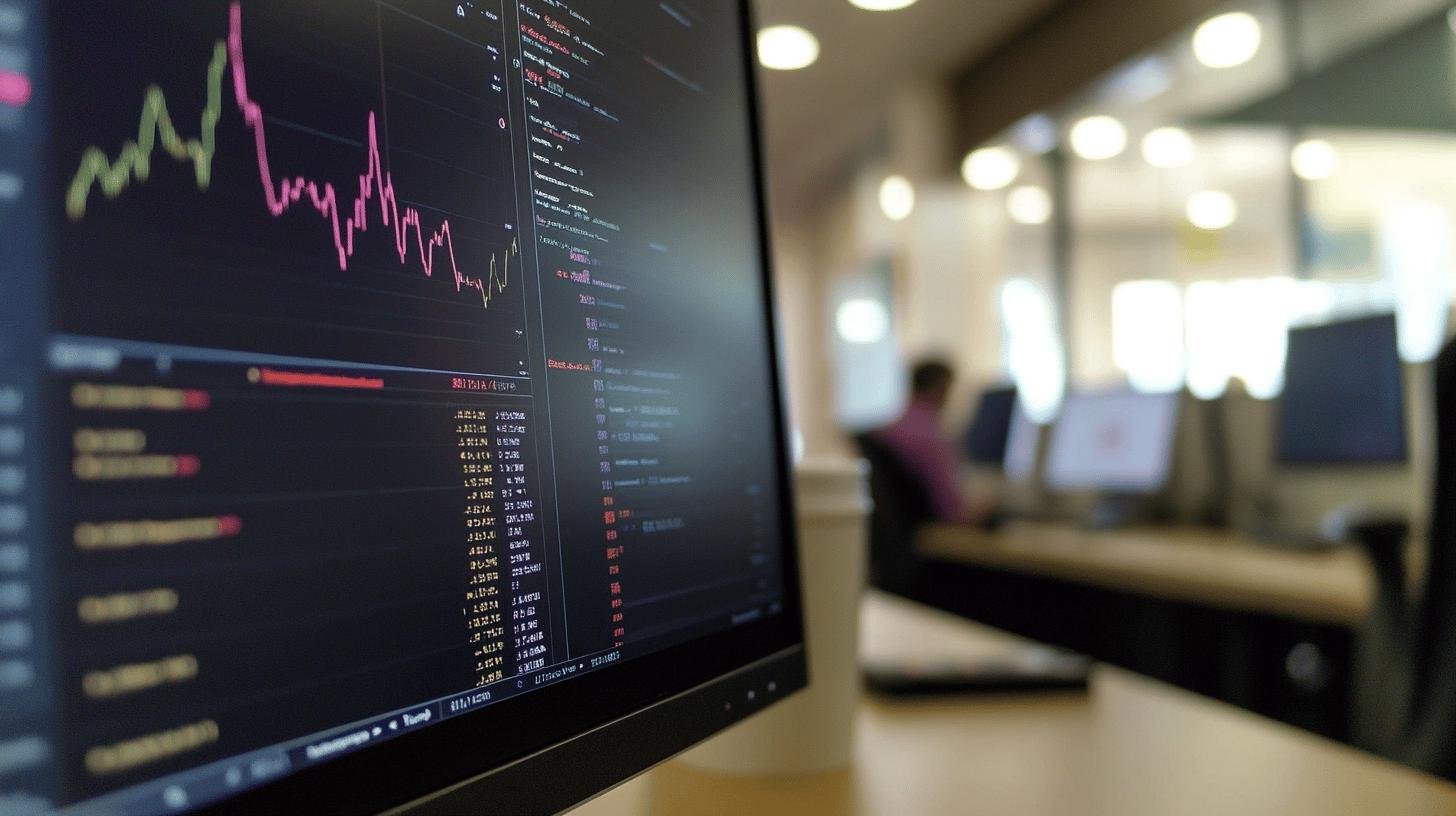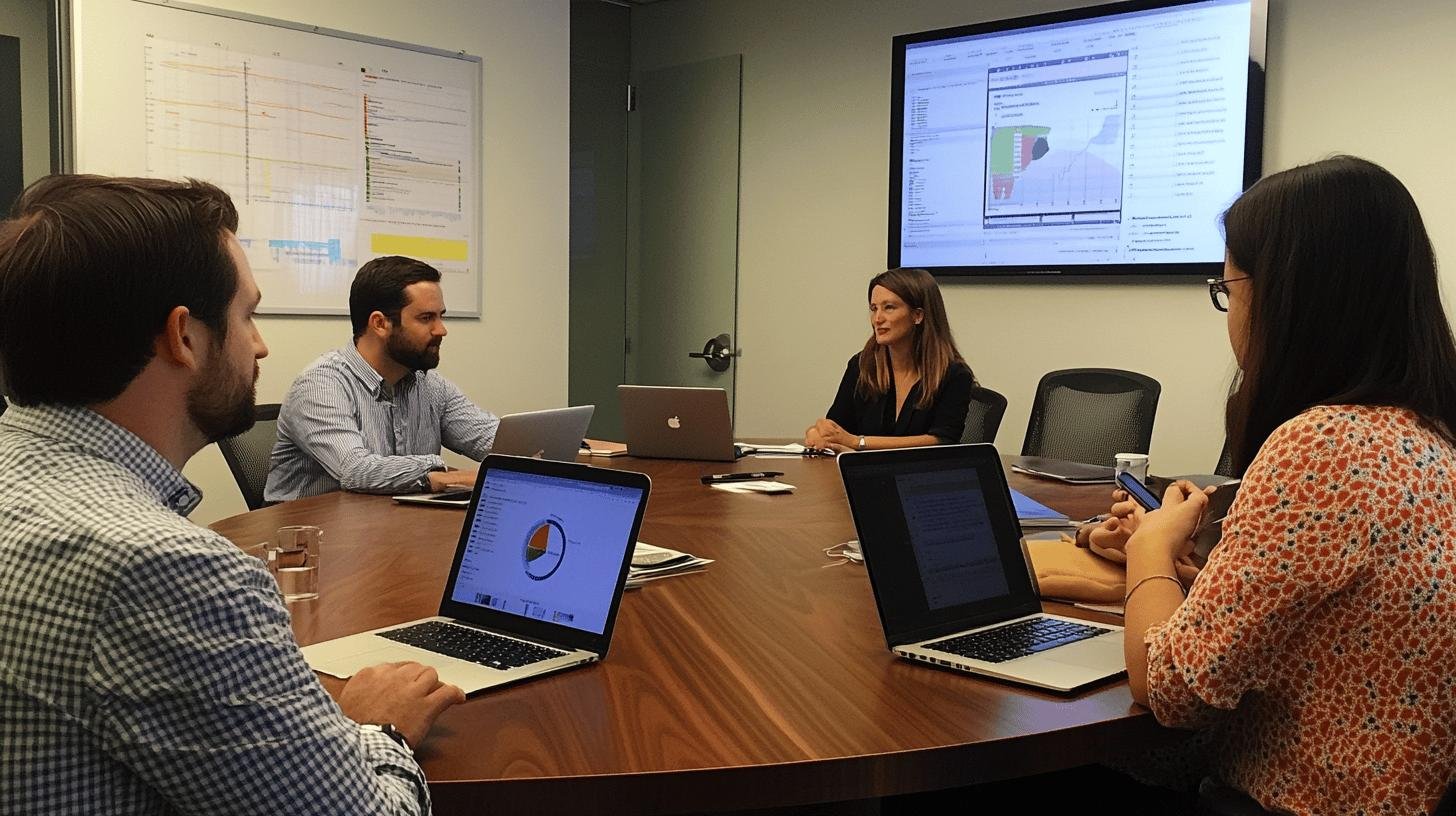TL;DR:
- Risk management technologies boost company efficiency.
- Key features include: real-time data access, scenario analysis, risk dashboards, and early warning indicators.
- AI boosts risk management through automated analyses, early warning systems, and data-driven decision-making.
- Blockchain secures data with an immutable ledger, enhancing transparency and trust.
- Financial services utilize cybersecurity solutions, credit scoring systems, and compliance monitoring for effective risk management.
- Implementing risk management requires a technology risk assessment to identify gaps, create a development plan, and adapt strategies as risks evolve.
- Proactive approaches improve decision-making and organizational resilience.
Are companies keeping up with modern risk management technologies? The old pen-and-paper ways of handling business risks don’t work in today’s fast-paced world. These days, risk management technologies are transforming how businesses deal with uncertainty by giving them instant information and handling tasks that used to take hours to complete by hand. In this post, we’ll explore how these modern tools, from risk modeling to “what-if” analysis, are doing more than just creating fancy charts—they’re completely changing how businesses plan for the future. Want to learn more? Let’s dive in.
Overview of Risk Management Technologies
Risk management technologies rely on real-time information to help teams report and solve problems quickly. Automated processes replace manual ones, cutting down on errors and boosting efficiency. Streamlining risk management allows organizations to tackle volatile situations with precision, ensuring timely and accurate risk management.
Advanced systems like risk modeling and scenario analysis are integral to improving risk management. These tools automate complex tasks, providing deeper insights that help organizations foresee and prepare for potential risks. This enables precise predictions so teams can create proactive strategies instead of just reacting to issues.
Key features include:
- Real-time data access
- Automated risk assessment
- Scenario analysis
- Risk dashboards
- Early warning indicators
These technologies significantly contribute to informed decision-making. By offering a full view of potential risks, they help organizations distinguish ignorance from awareness of recent trends. This insight improves operational efficiency and market sustainability through better decision-making.
The Role of Artificial Intelligence in Risk Management

AI in risk management boosts efficiency by reducing manual tasks and providing predictive insights. How does AI improve efficiency? By automating complex analyses and offering early warning systems, AI helps organizations foresee risks ahead of time. This shift not only saves time but also cuts human error, which is crucial for effective risk management.
Predictive Analytics in Risk Management
Predictive analytics is crucial to AI in risk management. How does it forecast risk scenarios? It processes large data volumes to identify patterns and trends that aren’t obvious. By examining historical data and current conditions, predictive analytics helps organizations prepare for potential risks. This proactive stance aids in informed decision-making, improving the ability to mitigate issues early on.
Critical features include:
- Automated risk analysis
- Predictive modeling
- Early warning systems
- Data-driven decision-making
AI enhances risk mitigation efforts significantly. How? By providing detailed threat analyses and swift solutions. The data-driven method reduces the guesswork in traditional risk management. AI improves business resilience by offering real-time insights and adapting quickly to new information.
Blockchain and Risk Management
Blockchain technology enhances risk management by ensuring secure and transparent data management. How does it accomplish this? It creates an immutable ledger preventing data tampering and unauthorized access. This transparency records accurate transactions, reducing fraud and errors. Its decentralized nature also protects critical data from single points of failure, boosting security.
In risk assessment, blockchain reliably tracks and verifies data integrity. How is it applied? It uses cryptography to ensure recorded data remains unchanged without detection. This builds trust in systems requiring great accuracy and reliability. Early discrepancy detection allows timely interventions, offering a robust framework for managing and assessing risks across various sectors.
Risk Management in Financial Services

Risk management technologies are crucial in financial services for data protection and compliance. How do they safeguard financial data? By implementing systems that monitor and manage risks effectively, preventing unauthorized access and mitigating cyber threats. This ensures the confidentiality and integrity of financial information, crucial for maintaining trust and preventing losses through breaches or non-compliance.
Credit Risk Management Tools
Credit risk management is vital in financial services. What tools manage credit risks? Financial institutions use technologies to assess creditworthiness and mitigate risks in lending. Credit scoring systems and fraud detection software evaluate borrower reliability and suspect activities. These tools provide a thorough assessment of potential risks, enabling effective credit portfolio management.
Key components include:
- Cybersecurity solutions
- Credit scoring systems
- Fraud detection software
- Data encryption tools
- Compliance monitoring systems
Risk management technologies ensure regulatory compliance by implementing monitoring systems tracking regulations. This prevents penalties and maintains industry reputation. Automating regulatory compliance allows financial services to focus on strategy, minimizing non-compliance risks.
Implementing Risk Management Technology in Organizations
Why is technology assessment crucial when implementing risk management tools? It helps organizations evaluate current capabilities and spot areas needing enhancement. This establishes a foundation for integrating new technologies aligned with organizational goals and risk needs.
How does one identify gaps and create integration plans? By thoroughly analyzing existing processes. This identifies specific vulnerabilities and inefficiencies, leading to a clear integration plan for smooth technology incorporation. The plan outlines changes and ensures stakeholder alignment.
Steps include:
- Conduct technology risk assessment
- Identify gaps in existing systems
- Develop a comprehensive implementation plan
- Monitor and adapt strategies as risks change
Why are adaptive strategies key for risk management effectiveness? As risks evolve, adaptive strategies maintain the relevance and effectiveness of implemented technologies. By tracking the risk landscape, organizations adjust strategies to counter new threats. This dynamic approach enhances resilience and maintains system efficiency against emerging risks.
Final Words
Risk management technologies help companies work smarter by providing instant access to important data and handling complex tasks automatically. When artificial intelligence joins the mix, it helps spot potential problems before they happen. Blockchain technology keeps data safe and transparent, which is especially important for banks and financial companies handling sensitive information.
Advanced tools like predictive modeling and early warning systems help companies see potential risks coming, leading to better decisions. To use these technologies effectively, companies need to check their current systems, find what’s missing, and be ready to change their approach as new risks emerge.
By embracing risk management technologies, companies can face challenges with confidence, knowing they’re prepared for whatever comes their way.
FAQ
What are risk management technologies and how do they work?
Risk management technologies are digital tools that provide real-time information and automate risk assessment tasks. They include dashboards and analysis tools that help companies track and manage potential problems before they happen.
How can small businesses benefit from risk assessment software?
Small businesses can use risk assessment software to spot potential problems early, save time on paperwork, and make better decisions based on data rather than guesswork.
What makes a good risk management system?
A good risk management system should be easy to use, provide clear reports, automatically alert you to problems, and help you track risks over time.
How much do basic risk management tools cost?
Basic risk management tools can range from free to several hundred dollars per month, depending on the features and size of your business.
When should a company upgrade its risk management approach?
Companies should upgrade their risk management approach when they notice they’re spending too much time handling risks manually, missing important warning signs, or struggling to keep up with industry safety standards.

